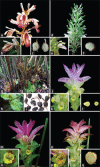Significance of gingers (Zingiberaceae) in Indian System of Medicine - Ayurveda: An overview
- PMID: 24991077
- PMCID: PMC4078479
- DOI: 10.4103/0257-7941.131989
Significance of gingers (Zingiberaceae) in Indian System of Medicine - Ayurveda: An overview
Abstract
Background: Family Zingiberaceae consists of the large number of medicinal plants and is well-known for its use in ethnomedicine and play a major role in Indian System of Medicine, Ayurveda.
Objective: The aim of this study is the documentation of Zingiberaceous plants used in Ayurveda, adding information to the systematics, vernacular names and chemistry with experimental data.
Materials and methods: The live plants were collected from wild and successfully conserved at Herbal Garden of Arya Vaidya Sala, Kottakkal. The experimental data of each species has been collected from the various sources. The photographs were taken and all relevant data documented.
Results and conclusion: A total of 13 species belonging to 7 genera of Zingiberaceae were documented. The work will be useful to students and researchers as it provides an easy access to Zingiberaceous plants used in Ayurveda.
Keywords: Ayurveda; Curcuma; Gingers; Indian System of Medicine; Zingiberaceae.
Conflict of interest statement
Figures


References
-
- Jantan IB, Yassin MS, Chin CB, Chen LL, Sim NL. Antifungal activity of the essential oils of nine Zingiberaceae species. Pharm Biol. 2003;41:392–7.
-
- Kress WJ, Prince LM, Williams KJ. The phylogeny and a new classification of the gingers (Zingiberaceae): Evidence from molecular data. Am J Bot. 2002;89:1682–96. - PubMed
-
- Sabu M. Kerala: Indian Association for Angiosperm Taxonomy, University of Calicut; 2006. Zingiberaceae and Costaceae of South India.
-
- Tomlinson PB. Studies in the systematics anatomy of the Zingiberaceae. J Linn Soc (Bot) 1956;55:547–92.
-
- Prabhu KM, Thomas VP, Sabu M. Proceedings 22nd Kerala Sci Cong KFRI; 2010. Economically important gingers; pp. 816–7.
Publication types
LinkOut - more resources
Full Text Sources
Other Literature Sources

